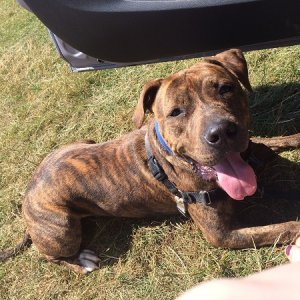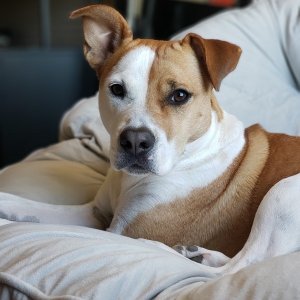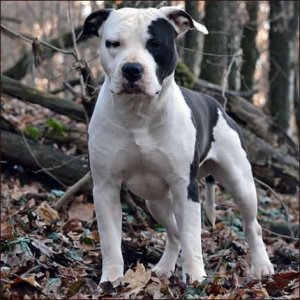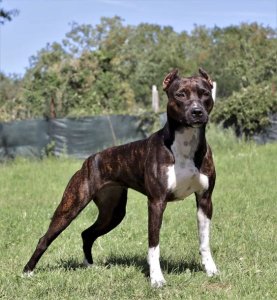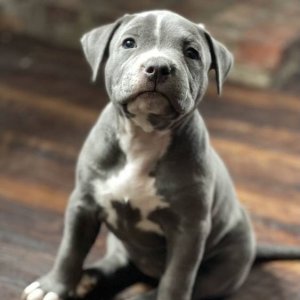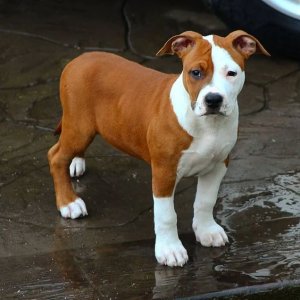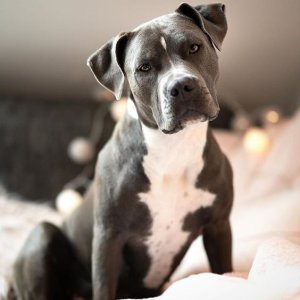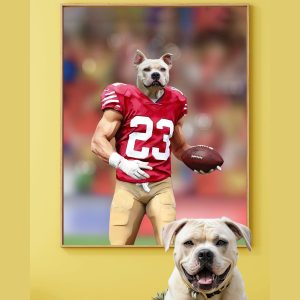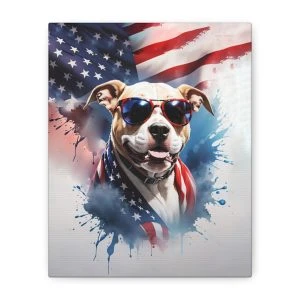American Staffordshire Terrier
Introduction: What Is an American Staffordshire Terrier?
The American Staffordshire Terrier, often referred to as the AmStaff is a robust, mid-sized canine slightly bigger than its cousin, the American Pit Bull Terrier. This breed boasts a coat that’s short, rigid, and has a lustrous sheen. Their ears can be either trimmed or kept natural. Their broad face is complemented by a set of formidable jaws. Despite their compact size, they exude strength, evident from their well-defined muscles. While their appearance might seem intimidating, they’re known for their affectionate and devoted nature, especially when nurtured in a caring setting.
When you look at their face, you’ll be drawn to their wide head, which houses powerful jaws. This breed is known for its strength, especially considering its size. Their noticeable musculature is a testament to their power and agility.
While they might look tough on the outside, many owners will attest to their loving and loyal nature. They are often great family dogs when raised in a loving environment.
This beloved American dog breed has a long, rich history and an unwavering devotion to their human families. They are a tenacious, healthy breed that forms intense bonds with their owners.
Let’s explore why the American Staffordshire Terrier has earned such popularity among active families and bully breed enthusiasts who are prepared to meet their needs and appreciate their unwavering devotion. When raised and cared for properly, these dogs make faithful, loving companions.
Origins and History of the American Staffordshire Terrier
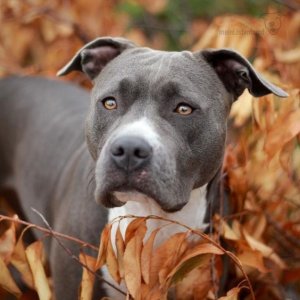
To fully appreciate this breed, it is important to understand the history behind its development starting in 19th century England.
Bull-and-Terrier Breed Origins
In England during the 1800s, breeders started crossing Bulldogs with various Terriers to develop agile, athletic “Bull and Terrier” dogs ideal for vermin hunting and bull baiting.
The result was a muscular, determined dog with boundless energy and tenacity balanced by a predictable, controllable temperament suitable for family life.
Some of the Terrier breeds believed to be included were the Black and Tan Terrier, Fox Terrier, and English White Terrier. These terriers lent speed, dexterity, and gameness to the mix.
The Old English Bulldog and possibly the Spanish Pointer or Whippet were also influential in providing strength, athleticism, and agility.
Selective breeding focused on courage, high energy, and fluid movement in a powerful, compact package. These Bull and Terrier crosses became popular among 19th-century English and Irish sportsmen.
Introduction to America
Immigrants brought descendants of these early Bull and Terrier crosses along with them to America in the mid-late 1800s. Dog fighting was a popular underground sport at the time, so these tenacious canines were highly valued.
Breeding programs in America refined these dogs further. The American Kennel Club (AKC) first recognized the breed as the Staffordshire Terrier in 1936. The name was later changed to American Staffordshire Terrier in 1972 to distinguish them from their British Staffordshire Bull Terrier cousins.
Owners and breeders sought predictability in temperament so these dogs could thrive as both sporting competitors and family companions. The American Staffordshire Terrier assisted in establishing and legitimizing their cousin, the American Pit Bull Terrier, as a recognized breed.
According to the AKC, Amstaff ancestors were also influential in the development of many popular dog breeds today including the Bull Terrier, Fox Terrier, Boston Terrier, and English Bulldog.
America’s Dog
During the first half of the 20th century, the American Staffordshire Terrier gained popularity as the quintessential American dog representing strength, athleticism, loyalty, and determination.
Prominent owners and breeders like Senator Little, John P. Colby, and Lester Elliot did much to establish and standardize the breed in America.
The Amstaff has come a long way from their fighting roots to be recognized as a loving, versatile companion breed today. Understanding their history provides insight into their personality, energy, and daily exercise needs.
American Staffordshire Terrier Size and Appearance
The American Staffordshire Terrier is a medium-large, stocky yet agile and graceful dog breed. Here are some of the key physical attributes and characteristics.
Height and Weight
According to the AKC breed standard, American Staffordshire Terriers should be:
- Height at shoulder: 17-19 inches for males; 16-18 inches for females
- Weight: 50-80 pounds on average depending on height and bone structure
This is compact compared to very large bully breeds but larger than more petite breeds like Frenchies or Boston Terriers. Proper condition and fitness are important and obesity should be avoided.
Muscular Physique
The Amstaff boasts a heavily muscled build featuring defined cheek muscles, a broad powerful head, a thick neck, and a deep chest.
Their body is solid with good tuck-up and strong hindquarters. Overall, their physique conveys great strength for their size. They are athletic, agile, and fluid in movement.
American Staffordshire Terriers serve various roles today, including guarding, watchdogs, assisting in law enforcement tasks, weight-pulling and agility contests, and being cherished as family companions.
Head and Facial Features
Some defining characteristics of the ideal American Staffordshire Terrier head include:
- Broad, deep skull
- Defined stop and powerful, pronounced cheek muscles
- Short foreface with a wide muzzle, rectangular shape
- Heavy, thick undershot jaw with scissor bite
- Dark, round eyes set far apart
- Half-pricked or rose ears are preferred but full drop is accepted
- Powerful jaws and lengthy muzzle
Their expression is keen, fearless, and full of interest.
Coat Appearance
The American Staffordshire Terrier coat is short, smooth, stiff, and glossy. Acceptable coat colors according to the standard include:
- All shades of red, fawn, buckskin, brown, black
- Solid/predominant colors preferred with some white accents allowed
- The blue color is a rare but allowed disqualification from confirmation shows.
Many have attractive patterns including brindle and black masks.
Brindle American Staffordshire Terrier
The Brindle AmStaff is a specific color variant of the AmStaff breed, characterized by its unique fur design. “Brindle” denotes the presence of dark linear patterns over a lighter base color. These lines can range from faint, narrow markings to pronounced, wide bands, reminiscent of tiger stripes. The primary hue is often a light tan or beige, contrasted by the darker bands which can be black or deep brown. Beyond their coat, Brindle AmStaffs possess the same characteristics as their counterparts. They’re muscular, loyal, and have a protective streak.
Their sleek, flashy coat requires minimal grooming compared to many breeds.
In all, their physique gives the impression of strength and athleticism balanced with grace and agility in a powerfully compact package.
Black Mask American Staffordshire Terrier
A Black Mask American Staffordshire Terrier is a specific color variation of the American Staffordshire Terrier breed. This dog has a distinctive dark-colored marking on its face, primarily around the muzzle and sometimes extending up to the eyes and forehead, resembling a mask. The rest of the body can be of various colors, but the “black mask” feature on the face sets them apart. Apart from this unique facial marking, the Black Mask American Staffordshire Terrier shares the same physical and behavioral attributes as other AmStaffs: a strong physique, a broad head, and a loyal and affectionate temperament.
In a nutshell, the Black Mask American Staffordshire Terrier is an AmStaff with a standout facial feature that adds to its charm!
American Staffordshire Terrier Temperament and Personality
The Amstaff is renowned for unwavering devotion and loyalty to its family and innate desire to please its owner. However, proper socialization and lots of training from a young age are key to shaping a stable, well-rounded temperament.
Confidence and Courage
The typical American Staffordshire Terrier is a self-assured dog displaying a stable demeanor. Their courage is infamous – they will stop at nothing to protect loved ones if threatened.
Yet they are innately able to control their aggression outside of conflict. Their bravery combined with iron will once made them prized competitors in the cruel blood sports of yore.
Extreme Bond to Family
Perhaps more than any other breed, Amstaffs tend to form particularly intense, close attachments with their families. Their greatest joy comes from pleasing and spending time with their beloved people.
They thrive on being included in family activities. Conversely, they are prone to separation anxiety if frequently left alone for long periods. Proper crate training, mental exercise, obedience work, and inclusion will prevent anxious or destructive behavior.
Kid-Friendly Companions
Thanks to their tolerant, patient nature, Amstaffs often excel with children when properly supervised and socialized. Their playful, goofy side comes out around kids.
Still, families with very young children should take care given the breed’s strength. As with any breed, supervision of dog-child interactions is a must.
Potential for Dog Aggression
Dog aggression toward unfamiliar dogs of the same sex can occur in Amstaffs, especially intact males. Proper socialization helps minimize this tendency.
Families with multiple dogs should use caution, leadership, and management to prevent skirmishes. Training helps establish authority and peace.
Importance of Training
Starting obedience training and socialization as a puppy lays the foundation for a well-mannered, stable Amstaff. With experienced handling using positive methods, they excel in working roles and home life.
Despite their often imposing appearance, a properly bred, socialized Amstaff has a friendly, docile temperament making them a loyal companion.
American Staffordshire Terrier Pit Bull Lifespan and Health Issues
When sourced from trustworthy breeders who conduct health checks, Amstaffs typically have a life expectancy of 12-15 years, provided they receive regular exercise, proper nutrition, and consistent care throughout their lives. Nonetheless, they might be susceptible to specific health issues.
Common Health Problems
- Hip Dysplasia – Malformation of the hip joint causing arthritis and lameness. Responsible breeders screen breeding stock using OFA or PennHIP certifications to minimize this inherited condition.
- Allergies – Both food and skin-related. Common food triggers include chicken, beef, dairy, and wheat/corn. Skin issues are often responsive to omega fatty acid supplements and a quality diet.
- Heart Conditions – Congenital heart disease can occur. Many reputable breeders perform annual cardiac exams by veterinary cardiologists before breeding.
- Joint Disease – Elbow dysplasia, luxating patellas, and ACL tears are all concerns due to their muscular build and activity level.
- Thyroid Disorder – Hypothyroidism has been observed in the breed. Annual testing helps breeders make informed choices.
- Cataracts/Eye Issues – Periodic ophthalmologist exams should screen for inherited eye diseases.
Areas of Concern
- Autoimmune Disease– The breed seems prone to some autoimmune conditions like lupus. Careful health screening aids breeding decisions.
- Bone Cancer – Amstaffs may have a slight predisposition for bone cancer according to some studies. Discuss any suspicious lumps with your veterinarian promptly.
- Bloat – Owners should be aware of bloat risk, especially in intact males and if exercising heavily before/after eating. This can be prevented with proper nutrition and activity timing.
Importance of Health Testing
All responsible Amstaff breeders should perform a full panel of recommended health screens on the sire and dam before breeding. No dog with genetic faults should ever be bred. Ask to see proof of health clearances.
With attentive care, preventatives, and early intervention, an Amstaff can beat the health odds and live a long, full life well into the senior years.
Grooming, Care and Nutrition
While their sleek coat requires less grooming than many larger breeds, Amstaffs do have some specific care needs.
Grooming Requirements
The Amstaff’s short glossy coat needs only weekly brushing to help remove loose hairs and distribute oils around their skin and coat. Use a natural bristle brush or rubber grooming glove.
Bathing only occasionally when truly dirty using a mild canine shampoo will help retain natural oils essential for their skin health. Their nails should be trimmed regularly as they are prone to cracking and splitting. Clean their ears gently every 1-2 weeks with a vet-approved cleanser to avoid infections developing in their floppy ears. As with any breed, daily tooth brushing and annual dental cleanings with your vet help prevent periodontal disease affecting internal organs.
Exercise Requirements
As an athletic, high-energy breed, American Staffordshire Terriers require at least 60-90 minutes of vigorous exercise every day. This can include long daily walks, jogging, hiking, swimming, playing fetch, or ideally having a large, securely fenced yard to zoom around in.
Mental stimulation through obedience work, food puzzles, and new experiences is also important to prevent boredom and destructive behaviors. Heavy-duty chew toys provide an acceptable chewing outlet. Young Amstaffs that don’t expend their energy properly can be rambunctious and difficult to manage.
Diet and Nutrition
A high-quality protein-rich diet with bioavailable amino acids from quality ingredients promotes proper muscle development and allows their active lifestyles. Look for dog foods formulated specifically for bully breeds.
Avoid corn, wheat, soy, and by-products. Natural, lean meats should be the first ingredient. Some owners opt for partially raw or home-cooked diets under veterinary guidance to control food intolerances.
Food allergies can cause itching and skin issues so discuss elimination trial diets with your vet if suspicious symptoms arise. Obesity can easily develop from overfeeding, so stick to standard feeding guidelines for weight gain and activity level.
Safe Housing
Amstaffs should live indoors with their families and not be relegated to outdoor kennels or runs. A securely fenced yard provides a safe potty area and room to exercise. However, they should sleep inside at night and spend most of their time with their family to prevent separation anxiety.
Proper identification microchipping and tags are vital in case an Amstaff ever slips away off-leash, as they can be less likely to be reclaimed due to breed-discriminatory policies. Take care if ever visiting areas with Breed Specific Legislation.
With attentive care, training, socialization, and veterinary care, an Amstaff will enjoy a fulfilling, healthy life as your loyal companion.
Effective Training Methods for American Staffordshire Terriers
Energetic, intelligent, and eager to please, Amstaffs are highly responsive to training as long as it is started early and relies on positive reinforcement techniques.
Obedience Foundations
Start socialization and basic obedience training early, ideally as soon as they come home with you. Consistency and structure will become the cornerstone of molding good behavior. Use plenty of small tasty treats, toys, praise, and playtime rewards to make training sessions fun. Practice short sessions daily to instill manners and important cues like:
- Sit, stay, down, come, heel
- Settle/mat training for impulse control
- Crate training for future vet stays or travel
Take occasional training courses or workshops to strengthen their skills and bond with you. Seek force-free, fear-free certified trainers only. While Amstaffs respond well to firm, fair guidance, harsh corrections or punishment can backfire. Training should be mentally and physically stimulating for both the dog and the owner!
Socialization Throughout Life Stage
From 8-16 weeks old, safely socialize your Amstaff puppy to a wide range of environments, people, children, other calm vaccinated dogs, and any stimuli they may encounter in life like strange sights and sounds. Create only positive associations with treats, toys, and praise.
Socialization is a lifelong process. Continue exposing your adult Amstaff to new experiences to build their confidence. Arrange controlled play dates with trusted canine friends. Seek out puppy and adult dog training classes with positive reinforcement. However, you should always use caution around dog parks.
Addressing Behavioral Issues
Common puppy pitfalls like mouthing, jumping, and destructive chewing are reduced through training and maturity. For more serious behavioral issues like aggression, extreme anxiety, or phobias, consult an experienced veterinary behaviorist. Identify and address the root cause using force-free modification.
With mental stimulation, clear structure, and positive motivation, an Amstaff can become a perfectly-behaved companion. Proper obedience training is crucial!
Are American Staffordshire Terriers Good Family Dogs?
Thanks to their affectionate, loyal nature, Amstaffs can make wonderful family companions when socialized early and supervised properly around children. They thrive on being part of family activities.
Gentle With Children
When raised with children from puppyhood on, Amstaffs often become very attached to and protective of the kids, though they may play a bit rough. Always monitor interactions due to the breed’s strength. As the Amstaff matures with kids, they become more trustworthy. Socialization helps prevent issues later on.
Multi-Dog Homes
With proper socialization and training, Amstaffs can co-exist successfully with other household dogs. Often opposite sex pairings do better. Be prepared to monitor play and step in to resolve any spats over toys, space, or attention. Never leave unfamiliar dogs loose together unattended. Generally, Amstaffs just want to be with their people.
Adaptable Nature
While a household without small kids is ideal, Amstaffs can thrive in any situation as long as they receive adequate exercise, training, and quality time with their family. Amstaffs who are rarely left alone, included in family life, and given a job to do are wonderful companions. They just want to be wherever their loved ones are!
Responsible Ownership
The whole family should participate in providing the Amstaff with proper outlets for exercise and training as well as structure and leadership. When given the attention, activity, training, and affection they need, few breeds reward their owners with such steadfast loyalty and devotion. Make them cherished members of your household.
American Staffordshire Terrier Puppies
Those considering adding an American Staffordshire Terrier puppy should understand the unique needs and challenges of raising this active, intelligent breed. Proper socialization, training, and care from the very start help set the foundation for a loyal, mannerly adult dog.
Energetic and Mischievous
Like most puppies, Amstaff pups are extremely energetic, exuberant, and playful. They will want to explore, chew, dig, and get into everything they can! This means constant supervision is required during the puppy stage whenever they are loose.
When you cannot actively watch your puppy, use confinement for their safety and your belongings. A playpen, crate, or small dog-proofed room prevents potty accidents around the house and keeps them from destroying shoes or furniture. It also protects them from getting into anything dangerous when unsupervised. Just be sure to also allow plenty of playtime with you. Structure and confinement help teach good behavior.
Early Socialization Is Vital
Flood your Amstaff puppy with a wide range of positive new experiences during the key 3-16 week socialization period. Introduce them carefully to new places, surfaces, sounds, sights, people, and vaccinated gentle dogs. Well-socialized pups have fewer behavior problems than adults. Arrange regular play dates with friend’s calm adult dogs. Sign up for puppy obedience courses using reward-based methods as soon as they are old enough.
Begin Obedience Young
Start basic obedience training using positive reinforcement methods at 8 weeks old. Focus on vital cues like Sit, Down, Stay, Come, and Leave It. Hand-feeding meals helps establish you as a benevolent leader. Keep training sessions short and upbeat! An Amstaff wants to please their owner. Capture and reward desirable behaviors like calmness, eye contact, and politeness.
Patience and Consistency
Housetraining and teaching good manners takes time, consistency, and patience with an Amstaff puppy. But stay positive and persistent, using confinement when you cannot actively supervise. Keep training sessions short, varied, energetic, and rewarding. Maturity and proper guidance help improve behaviors over time.
Raising an Amstaff puppy is a big responsibility and commitment. But the reward of a loyal, well-trained companion for life makes it incredibly worthwhile. An Amstaff aims to please if given structure.
Finding an American Staffordshire Terrier Puppy or Rescue
Locating a healthy, purebred Amstaff from an ethical source requires diligence and patience. Here are tips for navigating breeders or rescues.
Identifying a Responsible Breeder
Indicators of responsible Amstaff breeding programs:
- Experience, dedication, and proven reputability with the breed. Look for established breeders specializing in Amstaffs only, not multiple breeds.
- Emphasis on health, conformation, and temperament over profit. They invest in showing their dogs to prove soundness.
- Intensive health testing is well beyond the minimum requirements, with proof in the form of OFA numbers and specialist reports. No genetic issues should be present.
- Detailed pedigrees are available for inspection and guidance on pedigree diversity. Match unrelated lines.
- Willingness to be interviewed at length about practices and requirements. Contracts mandate spay/neuter of pet-quality pups.
- Lifetime breeder support and willingness to take back any dog if ever needed. Selective on where pups are placed.
Be prepared to wait 6 months to a few years for a puppy from the most committed breeders who often have long waitlists. It’s worth being patient for a breeder who does things the right way to better the breed long term. Those just seeking a quick profit will cut corners.
Amstaff Rescue Adoption Tips
If going the adoption route instead, be sure to:
- Ask about any known medical history and past behavior issues the dog experienced. Review vetting and speak to references. The more background available, the better.
- Spend time interacting with the Amstaff to assess your overall health, temperament, and energy level yourself. Have family members meet them too.
- Prepare for potential challenges in training and socialization. Unknown history means slightly less predictability.
- Properly transition the adopted Amstaff into your home environment and routine through patience and consistency.
While adopted Amstaffs comes with more uncertainty, they can still make wonderful companions for the right adopter who sets realistic expectations. Take time to find the ideal rescue Amstaff for your situation.
American Staffordshire Terrier Price & Ownership Costs
A major consideration for prospective pet parents is the cost of both acquiring and properly caring for American Staffies over its lifetime. Here’s an overview of expected expenses:
Amstaff Puppy Purchase Price
For a well-bred Amstaff puppy from health-tested, champion parents, expect to pay $1500 – $3000+ from quality breeders depending on pedigree and location. Rare coat colors and show prospects cost more. Avoid “bargain” pups without papers from questionable sources.
Rescue Adoption Fees
Adopting an adult Amstaff through a shelter or rescue averages $50 – $500 depending on the organization. While less expensive upfront, adopted dogs often have greater health and behavior uncertainties.
Ownership Costs
Responsible ownership also requires dedicating an ample budget to:
| Ownership Costs | Estimated Monthly Expense |
|---|---|
| High-quality dog food and supplements | $60 – $100+ |
| Veterinary exams, vaccines, preventatives | $75 – $200+ |
| Pet insurance for emmergencies | $30 – $100 |
| Training classes and treats | $50 – $150 |
| Toys, beds, gears, supplies | $40 – $80+ |
Purchasing from health-focused breeders and providing excellent preventative care reduces significant medical issues down the road. Owning any athletic breed means committing to regular, predictable expenses as well as potential emergencies.
The American Staffordshire Terrier Blue Controversy
While some prize the blue coat color, there is controversy surrounding blue Amstaffs and potential links to health problems that may disqualify them from responsible breeding.
The Blue Coat Explained
The blue dilution gene causes a steel grey to deep charcoal coat coloration in dogs. All blue Amstaffs inherit the recessive gene from both parents. Breeders intentionally select for blue ancestors.
Origins of Blue Amstaffs
Blue did not appear naturally in Amstaffs. It was introduced through crossing with other breeds like French Bulldogs to develop the unique coloration. The AKC eventually accepted blue as an allowable show color.
Potential Health Implications
Some studies have linked the blue dilution gene to increased risk for:
- Skin problems – alopecia, allergies, pyoderma
- Immune disorders – hypothyroidism, Cushing’s
- Eye defects – cataracts
However exact causes remain under investigation. Blue dogs should undergo thorough specialist health exams before breeding. Temperament may also be different.
Blue is controversial because while striking, deliberately breeding for color over health can lead to issues being propagated within bloodlines. Ethical breeders prioritize health first.
Knowledgeable Amstaff owners and breeders remain divided on this issue. The debate continues as research evolves.
American Staffordshire Terrier Vs Pitbull: Are AmStaffs Often Mislabeled as “Pit Bulls”?
Due to close lineage and physical similarities, Amstaffs often get mislabeled as Pit Bulls, causing problems due to public misconceptions about Pit Bull breeds.
Shared History
The American Staffordshire Terrier and American Pit Bull Terrier share a common history rooted in crossing Bulldogs and Terriers. The Amstaff played a pivotal role in establishing and legitimizing the APBT as a breed. They continue to be closely intertwined.
Overlapping Traits
Amstaffs and APBTs share many behavioral tendencies including athleticism, drive, and unwavering loyalty to their owners. Their physical build and musculature are also comparable.
Mistaken Identity
Because of overlapping lineage and traits, Amstaffs often get mistaken for Pit Bulls by shelters, media, legislation, and the general public. This leads to mislabeling and confusion.
Victims of Breed Stigma
Once labeled a “Pit Bull”, Amstaffs encounter many of the same issues like housing restrictions, insurance problems, and adoption barriers even though they are different breeds, with distinct standards and temperaments.
Correct Identification Is Crucial
Educating the public on properly identifying bully breed types as distinct breeds is important so they are not unfairly judged based on Pit Bull stigma. Accurately conveying an Amstaff’s temperament provides better adoption opportunities.
Advocacy and awareness reduce mislabeling, discrimination, and mistaken euthanasia of wonderful dog breeds like the American Staffordshire Terrier.
American Staffordshire Terrier Vs Staffordshire Bull Terrier
The American Staffordshire Terrier and Staffordshire Bull Terrier share close ancestry and many similarities but have evolved as separate breeds with some notable distinctions.
Shared Bull Breed Origins
While both descended from bulldogs crossed with various terriers, the Amstaff originated in the United States while the Staffordshire Bull Terrier was developed in England. Their histories overlap closely.
Size and Build Differences
- The American Staffordshire Terrier tends to be taller and heavier at 17-19 inches tall and 50-80 lbs compared to the Staffordshire’s smaller 16-17 inches height and 35-45 lb weight.
- The Amstaff has more pronounced muscle mass and a larger, blockier head shape than the leaner, more agile Staffy build.
Coat Variations
- Amstaffs exhibit a wider array of coat colors including black, blue, fawn, red, and brindle.
- The Staffordshire Bull Terrier standard only allows red, fawn, white, or brindle coats.
Temperament Nuances
- While both make excellent family companions, Amstaffs tend to focus devotion on their immediate family while Staffies are more openly friendly with all.
- Proper socialization and training are essential for both breeds to curb any dog aggression tendencies.
So while the breeds share close ties and similarities, the American Staffordshire Terrier and Staffordshire Bull Terrier have evolved as separate breed types, especially in terms of size, build, and allowable coat colors. Recognizing their nuances is important.
Educating the public helps ensure both breeds are better understood and not mistaken based solely on physical appearance similarities and overlap in origins.
FAQ’s
American Staffordshire Terrier Breed Summary
After reviewing this extensive guide, hopefully, you now have a strong understanding of the loyal, family-oriented Amstaff breed. Let’s recap some key points:
- Athletic, powerful medium-large breed of bull and terrier ancestry
- Thrives when provided adequate exercise, training, and socialization
- Forms exceptionally strong bonds with their family
- Dog aggression can occur but intraspecies issues are manageable
- Make faithful companions but require an experienced owner
- Require early socialization and positive obedience training
- Lifespan averages 12-15 years when properly cared for
- Prone to certain joint, cardiac, skin, and immune disorders
- Easy grooming but needs active lifestyles
- Excel as family pets, performance dogs, service dogs
- Make wonderful companions when responsibly acquired and raised
We hope this guide gave you a well-rounded overview of the American Staffordshire Terrier breed and some guidance on finding a happy healthy pup or rescue Amstaff to welcome into your home!

Mandy has lived with pitbulls her whole life, and she has amassed a wealth of experience and knowledge about these magnificent animals. Having had the pleasure of owning and caring for numerous pitbulls over the years, she has come to understand their unique characteristics, behaviors, and needs. Read more



